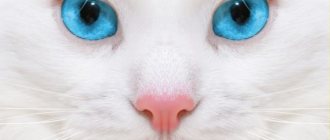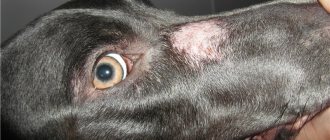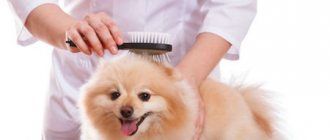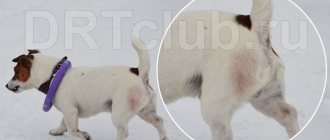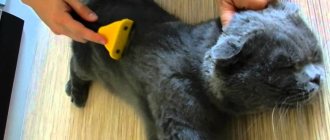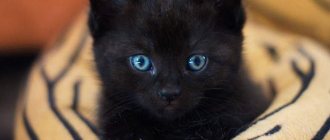If you begin to notice that your cat is losing a lot of hair, and this does not look like the usual seasonal shedding, since whole shreds end up on the bedding and floor, it means that there is something wrong with the pet, it doesn’t have enough vitamins, it has allergies and etc. Often, the fur loses its beautiful appearance, and the pet licks itself so actively that bald spots form.
The cat, the cat is climbing a lot, hair is falling out: it’s time for cats and cats to shed
A cat's healthy, shiny hair is the pride of its owner. But what a disappointment if cat hair is observed every now and then in all corners and places in the apartment. The problem of hair loss in cats is not uncommon. Sometimes there is no need to worry, but there are times (and they happen often) when the animal should be examined. Let's figure out in order why cats shed and how to deal with it.
Cat owners know that every day they have to clean up hair in their house or apartment. This is a completely natural phenomenon; people also lose some hair every day.
Important: Twice a year, cats lose more hair than usual. Don't be alarmed right away, this could be seasonal molting.
As a rule, the beginning of seasonal molting is very scary for “newbies”. Experienced owners who have had a pet for several years perceive this phenomenon calmly.
Shedding in cats: what to do?
Seasonal shedding does not depend on the pet’s diet, humidity level in the house, care and other factors. It’s just that a cat changes its summer coat to a winter coat and vice versa. This phenomenon is quite normal, and nothing needs to be done about it. The only thing you can do to help your pet is to brush its fur more often. Molting occurs in spring and autumn. In what time frame - each animal individually.
If you see that your cat has begun to shed, first examine your pet's skin, nose and eyes. If the eyes and nose are clear, the skin is pink, and there are no bald spots, just wait a little. Everything will be back to normal soon.
If the problem is not as simple as it seems at first glance: the fur begins to come out in clumps, the shedding is prolonged, bald spots appear on the animal’s body - this is a reason to immediately consult a doctor.
How to choose the right vitamins?
So, you noticed that your cat's hair is shedding a lot. What to do? If you are sure that the pussy is healthy and there is no reason to visit the veterinarian, you can simply buy a special vitamin complex. The choice will depend on several factors:
- age of the cat (vitamins are different for kittens and old cats);
- presence of pregnancy;
- preservation of the ability to reproduce (castrated and sterilized animals need a special complex);
- release form of the drug (gel, tablets, drops, paste);
- availability of a product certificate.
The cat's hair is constantly falling out in clumps, all year round, in summer and winter: reasons
The causes of excessive hair loss, which is permanent, can be very different. However, they all indicate one thing: not everything is in order with the animal’s body. Let's look at it in order:
- Lack of vitamins . The cat's diet should be balanced. Special food contains a certain amount of vitamins that are necessary for the cat's body. If you feed your cat natural products, pay attention to the diversity of the diet. Sometimes, due to an unbalanced diet, cats develop allergies or dermatoses.
- Hormonal disbalance . Often, owners suppress the cat’s sexual desire with special drugs. In this case, hormonal imbalance may occur. Along with hair loss, hormonal imbalance reveals itself through the following signs: cat apathy, reluctance to approach the food bowl, weakness, unusual behavior.
- Ringworm . Round bald spots appear on the animal's body; the skin in these places may be reddened or too white, and there may also be scales. In this case, a visit to the veterinarian is extremely necessary, since the disease is dangerous, not only the animal suffers, but people can also become infected.
- Skin mites and helminths . A sign of skin mites is baldness of the face, paws, and ears. Pay attention to how often your cat itches. Helminths are also a serious problem; they have a detrimental effect on the functioning of internal organs and externally manifest themselves in the form of dermatoses.
It is a mistake to think that worms or skin mites cannot appear in a cat that does not go outside. Even if a cat does not eat raw meat, it is not a fact that it will not become infected with worms. These parasites can be brought into the house on shoes or clothes.
Dermatomycosis in cats
Important: Another cause of hair loss in cats can be stress. Like people, cats are prone to anxiety and overstimulation of the nervous system.
What may seem insignificant to a person may be perceived as painful by a cat. This includes physical and emotional factors.
Physical stress factors:
- Electric shock;
- Burns;
- Injuries;
- Past illnesses.
Emotional factors:
- Moving to a new place;
- The appearance of new residents (animals or people) in the house;
- Loss of owner;
- Restriction of freedom.
These or other events may not necessarily cause hair loss and deterioration of the cat’s condition, but it is still worth paying attention to the nervous shock of your beloved pet.
Hair can be shed all year round
Other diseases
Veterinarians include helminthiasis, allergic reactions, autoimmune pathologies and dysfunction of internal organs as other causes of receding hairline and bald spots. Hair loss is just the least of the problems. In some cases, an animal left without treatment may die.
Infection with worms
The waste products of worms lead to severe intoxication of the body and gradual failure of internal organs. An infected animal loses its appetite, vomiting and diarrhea. His fur is thinning and dull. Despite the dramatic weight loss, the belly remains round and firm.
Allergy
Allergies can be food or non-food. Detecting the allergen on your own is problematic, so treatment is often prescribed before the pathogen is identified.
In addition to alopecia, an allergic reaction from the skin may be accompanied by severe itching. Scratching can cause the damaged areas to become red, flaky, and blistered or eczema-like. Tearfulness, rhinitis and gastrointestinal disorders may occur.
Autoimmune diseases
Autoimmune (focal) alopecia is a malfunction of the body. Immune cells begin to produce antibodies to destroy their own cells, mistaking them for foreign ones. Hair follicles are affected. Antibodies not only destroy existing hairs, but also prevent the formation of new ones. Bald areas are no longer restored.
This disease, like all immune pathologies, is very rare. Areas affected by alopecia grow over time. Without timely treatment, the condition of the coat will only worsen. The sides, groin and thighs of the animal are primarily affected.
Hyperthyroidism
Hyperthyroidism is a pathology of the thyroid gland that disrupts the natural amount of hormones produced. Due to increased levels of hormones, the cat develops seborrhea. He constantly licks himself, and when he is stroked, tufts of fur remain on his hands.
Hyperthyroidism is a secondary disease. It occurs with pathologies of the liver and kidneys, disorders in the gastrointestinal tract and immune system. In addition to alopecia, symptoms may include diarrhea, vomiting, loss of appetite, increased urination and weight loss.
What to do, what to feed, what to give to a cat to prevent hair from coming out?
When a cat has a problem with hair loss, owners ask themselves: what to do? Your actions in this case are mandatory; inaction can lead to deterioration in the health of the pet, and sometimes other household members.
First of all, make sure that it is not shedding. If you see that the problem is serious, analyze the animal's diet. Create a menu for your cat:
- Introduce low-fat varieties of fish, meat, offal, cottage cheese and milk into your diet.
- Don't give your cat milk instead of water. Milk should act as a separate food, no more than 1-2 times a week.
- Do not overfeed cats, especially older ones.
If your cat is used to ready-made food, it may be worth buying a higher quality food. There is also a special medicated food for cats prone to dermatitis. It is impossible to find out exactly which vitamin an animal lacks at home. This requires a visit to the veterinary clinic.
A rich diet and balanced nutrition are the key to healthy cats
In the case when the cat’s hair falls out and the cat’s skin itches due to allergies, you can add ⅛ of a suprastin tablet to the food 2 times a day. The source of the allergy, of course, needs to be found out and removed.
There are special vitamins for cats that can be given during the molting period, as well as for hormonal disorders. An experienced veterinarian will tell you what is best to give specifically in your case.
If you see that a balanced diet is not helping and your cat is losing more and more fur, consult a doctor. Do not neglect consulting a specialist, because a cat’s skin disease can be transmitted to people, for example, mycosis. Correct diagnosis and prescription of suitable treatment will help your pet to be cured faster.
If your pet has been found to have lichen, lice and other parasites that live on the body, take care not only of treatment, but also of disinfection of the home. Furniture and carpets should be thoroughly disinfected, and the animal's bedding should be replaced with new one.
What to do if your cat is going bald?
Medicines
Removing parasites is the first step to fluffy, beautiful fur. First, an insecticidal treatment is carried out aimed at exterminating lice, fleas, and ticks. For this purpose, drops, sprays, and shampoos are purchased at the zoological pharmacy. They should be used strictly according to the instructions, without exceeding the concentration, dosage, or procedure time, so as not to poison the pet.
Be sure to read:
What is pyoderma in cats, symptoms and causes of the disease
The use of dichlorvos and other chemicals not intended for cats is strictly prohibited. If there are a large number of fleas, the treatment is repeated after 7-10 days. Suprastin and diazolin in the dosage recommended by the veterinarian will help relieve itching.
3-7 days after treating the external parasites, a drug is given to remove helminths. The tablet is taken in the morning, along with food, the required dose is calculated according to the cat’s weight. If worms are found in the stool after this, you need to repeat taking the drug after 10-14 days.
How to care for a cat so that their fur does not fall out?
Below are general guidelines to help keep your cat's skin healthy and have a strong, shiny coat:
- Monitor your cat's diet and enrich it with vitamins and minerals.
- If you buy ready-made food, choose high-quality food, do not be fooled by the low price.
- Bathe your cat and don't forget to brush its fur regularly.
- Keep the animal's bedding clean.
- Vaccinate your cat against ringworm.
- Give medications for worms according to the regimen selected by the doctor.
Now you know what to do and what to look for if your cat is losing hair. Proper care and care for your pet will ensure a healthy life for you and a calm life for you.
Popular cat vitamins for a healthy coat
There are a lot of preparations to improve the condition of the coat. It is best if they are selected and prescribed by a doctor. The most popular vitamins for cats against hair loss are:
- "Farmavit Neo";
- Cat Felltop Gel;
- "Vittri";
- Laveta Super For Cats;
- "Phytomins";
- Derm Liquid;
- "Sherstevit";
- Derm Caps;
- "Beafar";
- Gimpet Katzentabs;
- "Kitzim";
- Kitty's + Taurin + Biotin;
- Canina Cat-Fell OK;
- “8 in 1 Brewer’s Yeast Excel”;
- "Felvit."
How to choose the right device?
To choose the right furminator, it is important to pay attention to the following points:
- Scallop width. The larger the animal, the wider the comb should be.
- Length of teeth. It should match the length of the animal's fur. Teeth that are too short will not reach the undercoat of “fluffy cats,” and teeth that are too long will not be suitable for short-haired cats.
- Quality of tooth sharpening. They should be even, smooth, without nicks or irregularities. Defects in sharpening interfere with quality combing. Irregularities will tug the fur and injure the skin. To check the quality of sharpening, run the furminator over your own head. If you do not experience any unpleasant sensations, the quality of sharpening is normal. Pulling hair? The sharpening was unsuccessful.
- Ejector button. Its presence allows you to get rid of hairs on the work surface in one motion. It must be remembered that such devices fail faster.
- Comfortable handle. It is best if the handle is rubberized, has a convex relief and a rounded end. Hold the Furminator in your hand, feel its weight, and measure the length of the handle against your palm.
Not long ago, universal furminators went on sale. They have removable combs of varying lengths and widths. With their help you can care for several pets of different sizes. But the moving connection becomes loose over time and the device becomes unusable.
Diagnosing the causes of baldness
In order to prescribe treatment for a cat and give its owner recommendations on maintenance, the veterinarian must determine why the bald spot appeared on the neck or paw. The cause is determined by exclusion; this approach requires professionalism from the doctor and attentiveness from the cat’s owner.
INTERESTING! If a problem with fur occurs, you need to carefully examine the cat, its fur and skin. If a cat that has hair on its hind legs has a rash elsewhere on its skin, either small or large, a diagnosis of allergic dermatitis may be possible.
With allergies, the pet owner may experience watery eyes, sneezing, and hair falling out in large clumps. The specialist will prescribe comprehensive treatment.
Such severe baldness is usually observed during an acute allergic reaction. Without eliminating the cause of the allergy, it will not be possible to cope with wool problems.
Problems with the endocrine system
Alopecia, caused by disturbances in the endocrine system of cats, is not so rare. The specific endocrine disease may vary. Additional symptoms of hypothyroidism are lethargy, sometimes obesity, and decreased body temperature.
With hyperfunction of the adrenal cortex, swelling appears. What bald cats look like due to the endocrine system can be seen in the photos of special sites about feline health; accurate illustrations will help owners quickly recognize the disease in order to begin its treatment.
Consequences of injury
Observing a cat after it has fallen and been severely injured, you will notice that it has also lost a lot of hair on some parts of its body. Sometimes injuries are visible and easy to diagnose, but they can also be hidden, which is even more dangerous.
Hair loss is sometimes the only visible symptom of internal injuries. Therefore, having detected the appearance of alopecia after a fall of a pet, you need to immediately report this to the veterinarian observing the cat.
Bald spots in combination with fearfulness and wariness quite accurately indicate the stress the cat has experienced. With this state of psychological health, the pet does not want to be handled, does not allow itself to be petted, looks for secluded corners, and may flinch from sharp and loud sounds.
IMPORTANT! As you can see, bald spots on a cat’s body always indicate some kind of health problem, so this symptom cannot be ignored.
